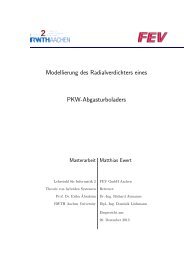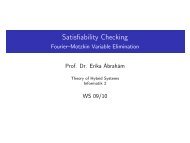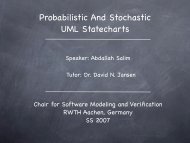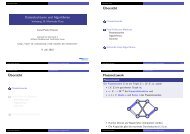1. Exercise sheet Static Program Analysis 2011
1. Exercise sheet Static Program Analysis 2011
1. Exercise sheet Static Program Analysis 2011
You also want an ePaper? Increase the reach of your titles
YUMPU automatically turns print PDFs into web optimized ePapers that Google loves.
Software-Modellierung und Verifikation<br />
Informatik 2<br />
Prof. J.-P. Katoen<br />
RWTH Aachen<br />
Priv.-Doz. T. Noll noll@cs.rwth-aachen.de<br />
J. Heinen heinen@cs.rwth-aachen.de<br />
Ch. Jansen christina.jansen@cs.rwth-aachen.de<br />
<strong>1.</strong> <strong>Exercise</strong> <strong>sheet</strong> <strong>Static</strong> <strong>Program</strong> <strong>Analysis</strong> <strong>2011</strong><br />
Due Mon, 02. May <strong>2011</strong>, before the exercise course begins.<br />
<strong>Exercise</strong> <strong>1.</strong>1: (3 points)<br />
The available expressions analysis as presented in the lecture detects for a given program when an expression is<br />
available. Modify the analysis in a way that it detects when an expression is available in a particular variable: an<br />
expression a is available in x at label l if it has been evaluated and assigned to x on all paths leading to l and if<br />
the values of x and the variables in the expression have not changed since then.<br />
Develop the dataflow system for this analysis including the kill- and generate-function.<br />
<strong>Exercise</strong> <strong>1.</strong>2: (3 points)<br />
Perform a live variable analysis for the following program:<br />
y := 1;<br />
while x > 0 do x := x − 1;<br />
y := 2;<br />
<strong>Exercise</strong> <strong>1.</strong>3: (1+1+1 points)<br />
Consider the following labelled program:<br />
[x := 1] 1 ;<br />
[x := x − 1] 2 ;<br />
[x := 2] 3 ;<br />
(a) At which labels is x live, and at which dead? (You need not perform a live variable analysis to confirm your<br />
answer!)<br />
(b) Does the result of the live variable analysis always make sense? Point out where the live variable analysis<br />
could be improved.<br />
(c) Sketch how the live variable analysis could be adapted/improved with respect to (b) and describe the important<br />
changes in more detail.<br />
<strong>Exercise</strong> <strong>1.</strong>4: (2 points)<br />
Providing you with a counterexample for the lemma on lecture slide 3.23 (alternative characterisations of of complete<br />
lattices):<br />
“Consider the partial order P O = (D, ⊆) with domain D = {{a}, {b}, {a, b}}. Obviously, every subset of D has<br />
a least upper bound - in ‘worst case’: {a, b}. Hence, according to the lemma, P O should be a complete lattice.<br />
But the subset {{a}, {b}} ⊂ D has no greatest lower bound, thus P O is not a complete lattice. Consequently, the<br />
lemma is wrong.”<br />
Now, find out and explain what is wrong with the lemma given in the lecture or with the counterexample given<br />
here.
<strong>Exercise</strong> <strong>1.</strong>5: (3+1 points)<br />
Given a partial order (D, ⊑) a maximal element of D is a dmax ∈ D such that<br />
A minimal element of D is a dmin ∈ D such that<br />
∀d ∈ D.dmax ⊑ d =⇒ dmax = d.<br />
∀d ∈ D.d ⊑ dmin =⇒ dmin = d.<br />
(a) Prove that a partial order (D, ⊑) with D finite has at least one maximal element.<br />
(b) Let D = {{1, 2}, {1, 2, 5}, {1, 2, 3}, {2, 3}, {2, 3, 5}} and define ⊑ as the set inclusion. Find all minimal and<br />
maximal elements of D.<br />
(c) Can you think of any dependencies between minimal/maximal elements and least upper/greatest lower<br />
bounds? Which? Argue why.<br />
<strong>Exercise</strong> <strong>1.</strong>6: (1+1+1 points)<br />
Let A be the set of all words in English and<br />
R = {(x, y) ∈ A × A| all the letters in the word x appear, consecutively and in the right order, in the word y}.<br />
Let B = {boat, house}.<br />
(a) Show that (A, R) is a partial order. Is it a total order? Why?<br />
(b) Does B have any upper or lower bounds?<br />
(c) Is B a complete lattice? Why?<br />
<strong>Exercise</strong> <strong>1.</strong>7: (1 point)<br />
Show that the least upper bound of a chain is unique (if it exists).












